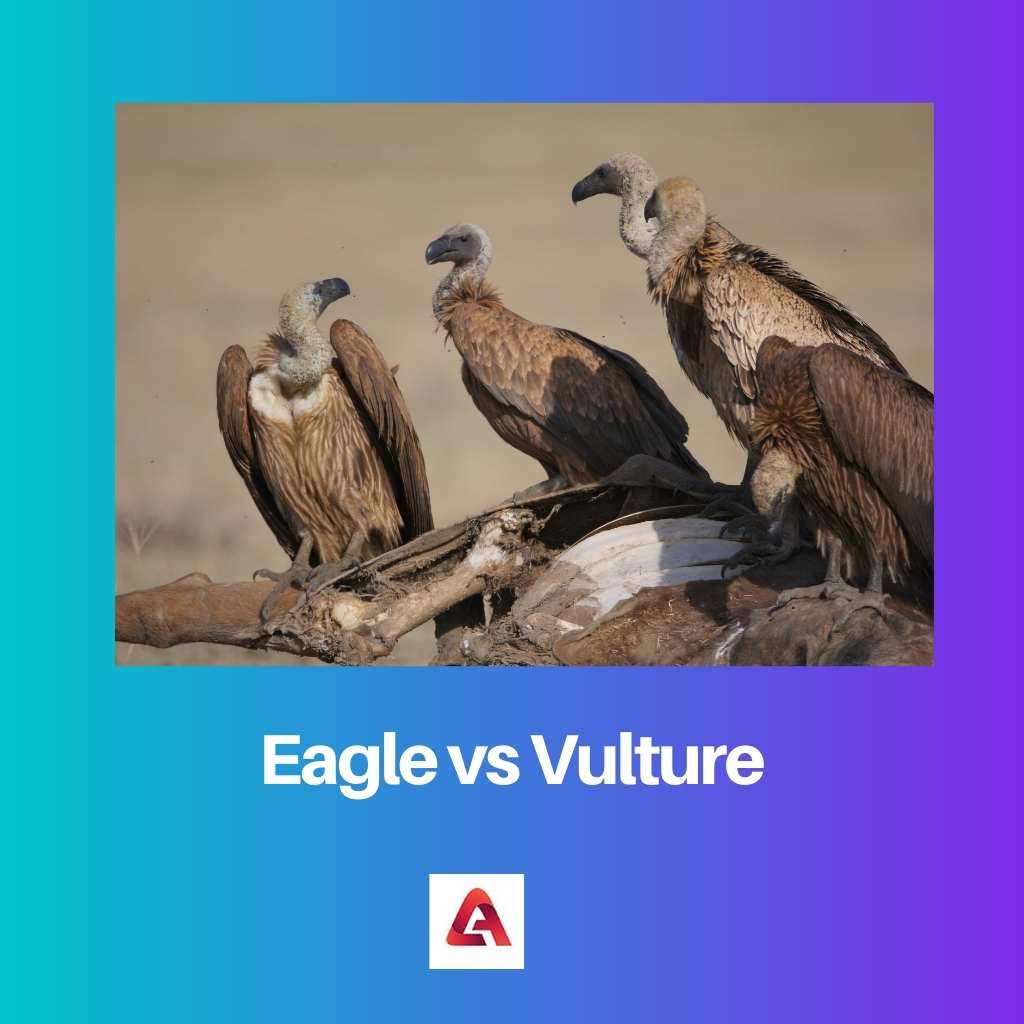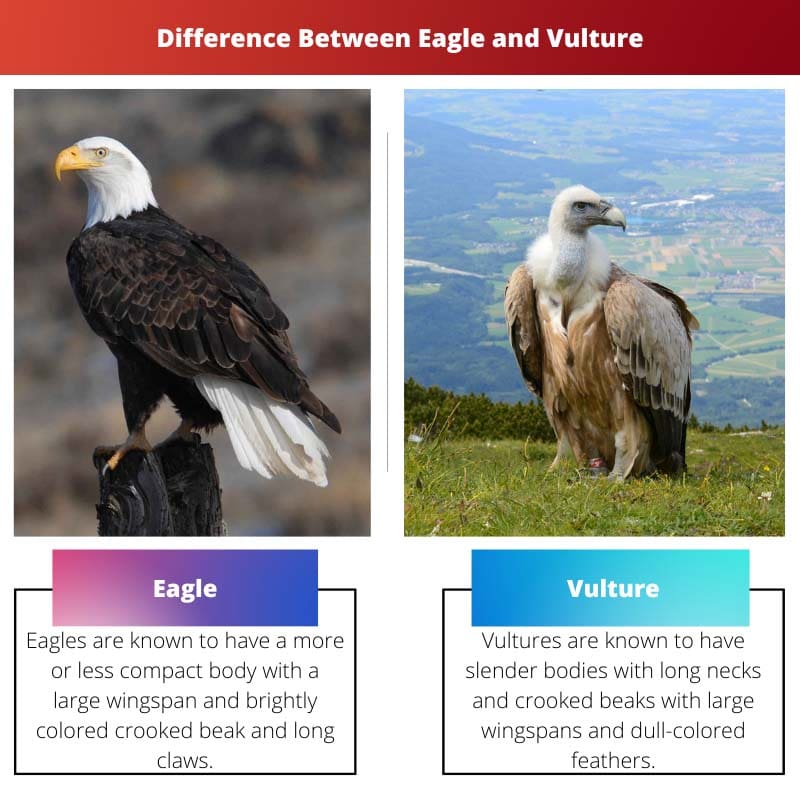Eagles and vultures are very similar in the way they look, but they are very different in their behavior. They both have bald heads and are covered in feathers.
The major difference between eagles and vultures is the way they eat. There are also other physical and behavioral differences.
Key Takeaways
- Eagles are powerful birds of prey with sharp talons and beaks, while vultures are scavengers that primarily feed on carrion.
- Eagles have a more agile and majestic appearance with a strong, streamlined body, whereas vultures have a hunched posture and a bare or featherless head.
- Vultures play a vital role in maintaining ecosystem balance by consuming dead animals, while eagles help control prey populations through active hunting.
Eagle vs Vulture
An Eagle is a large and powerful bird which has large, sharp talons and a sharp, curved beak. Eagles are carnivorous and hunt for their prey, catching smaller birds and mammals. Vultures are birds that have a more awkward appearance and have a bald head and a weak, hooked beak.

An eagle is a type of bird that is active and powerful. Eagles are found in various regions around the globe, including Europe, Africa, and North America.
Eagles are also known for their majestic appearance, which can be recognized by their distinctive feathers. Eagles have been known to have a lifespan between 25 and 30 years.
Vultures are also birds of prey, but they differ from others. They are large birds of prey that scavenge carcasses of dead animals.
They are found in Africa and some parts of Asia, and they have wingspans that reach up to 8 feet. They also have characteristic long necks and crooked beaks.
Comparison Table
| Parameters of Comparison | Eagle | Vulture |
|---|---|---|
| Scientific Name | The scientific name of Eagle is Aquilla sp. | The scientific name of vulture is Gyps sp. |
| Appearance | Eagles are known to have a more or less compact body with a large wingspan and brightly colored crooked beak and long claws. | Vultures are known to have slender bodies with long necks and crooked beaks with large wingspans and dull-colored feathers. |
| Found In | Eagles are found distributed around the world in favorable habitats. | Vultures are mostly found in the tropical regions of the world. |
| Feed On | Eagle feed on live animals that they can hunt for food like small rodents, deer, fished, and smaller birds. | Vultures mainly sustain themselves on a diet of dead and decaying carcasses or all sorts of animals. |
| Prevalence | Eagles are not classified as rare. | Vultures are classified as endangered species of animals in some parts of the world. |
What is Eagle?
An eagle is a large bird of prey in the Genus Aquila. Eagles are found throughout the world. The eagle is so iconic to the United States that its image is used as a national symbol.
Eagles are majestic, beautiful, and mobile birds. They can fly very fast and can move in any direction in the sky at large speeds and heights.
Eagles are known for their climbing ability, speed, and hunting tactics. They will catch prey in their talons and then swallow it whole.
They can even lift animals that weigh more than they do, such as calves. Some other birds of prey include vultures, falcons, and kites.
They have long, sharp talons and a hooked beak. Eagles are known to have a strong sense of sight and smell. They eat fish and small mammals and are the national bird of several countries.
Some species of eagles can live up to 40 years. They are also very territorial.
Eagles have keen vision, which allows them to spot their prey from great distances.
Eagles are powerful birds because they can fly with their heavy bodies and are excellent hunters, capable of catching prey that is much larger than themselves.

What is Vulture?
Vultures belong to the group of birds of the order Falconiformes. They are birds of prey (raptors) that are characterized by a large head, a hooked beak, and a pair of large, broad wings.
The size of these birds ranges from the Little Crow, which is as big as a Raven, to the Egyptian Vulture, which can have a wingspan of up to 9 feet.
The color of these vultures varies, from the Snowy-headed Vulture with its white feathers to the Tawny Fish-eagle’s gray feathers. A vulture is a scavenger bird that feeds on the flesh of dead animals.
When a vulture feeds on a decaying animal, it cleans the area and aids in nature’s cycle. Vultures are found circling the sky, and they are very large birds.
The vulture is a bird of prey that is a scavenger, feeding on dead and decaying animal and plant material.
These birds are mainly found on all continents where there are large numbers of dead animals, such as Africa and India.
They have a very special role in the ecosystem. Instead of feeding on the living animals for food, they rely on death.

Main Differences Between Eagle and Vulture
- Eagles live in desolate areas of the world, such as deserts and mountains around the world, while vultures are predominantly found to live in the tropics, Australia and Africa.
- Eagles are birds of prey. They mainly eat small mammals, fish, and reptiles. Vultures are scavengers and feed on carrion, which means they eat dead animals.
- Eagles are approximately 10 to 20 pounds and have a wingspan of around 5 to 8 feet. On the other hand, vultures can weigh 8 to 12 pounds and have a wingspan of up to 10 feet.
- Eagles hunt for food and eat it on the spot, whereas vultures don’t hunt for food.
- In comparison to eagles, vultures have a weaker sense of smell.

- https://digitalcommons.unl.edu/johnsgard/52/
- https://www.cell.com/current-biology/pdf/S0960-9822(16)00134-2.pdf
- https://books.google.com/books?hl=en&lr=&id=juj5CQAAQBAJ&oi=fnd&pg=PP1&dq=vultures&ots=AlAElObZ9D&sig=U9C7CtBJaY3ww8ZyepjMnnXrdZE
